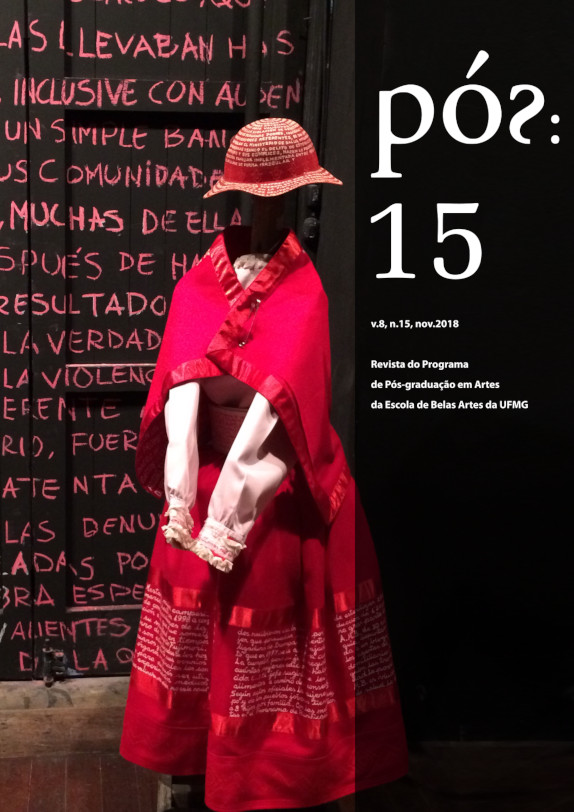ACTOR TRAINING, MINDFULNESS AND NEUROSCIENCE
FROM PARADIGMATIC ANALYSIS TO INSTRUMENTAL APPLICATION
Keywords:
Mindfulness, Neuroscience, Actor's trainingAbstract
This article provides a brief dialogue between the practice of mindfulness and the actor’s training from some neuroscientific evidences that prove the psychophysical benefits associated to the development of the attention capacity. Initially, the text makes a paradigmatic analysis in which the meditative practice serves as an example for the questioning regarding the importance of attention for the work of the actor. In a second moment, the present article seeks to highlight the advantages that the exercise of mindfulness can offer for the development of the psychophysical potential and the creative processes of the theatre artist.
References
BARBA, Eugenio e SAVARESE, Nicola. A Arte Secreta do Ator: Dicionário de Antropologia Teatral. Campinas: Ed Unicamp, 1995.
BONFITTO, Matteo e OLINTO, Lídia. A intersecção entre reprodutibilidade e espontaneidade no trabalho do ator. Urdimento – Revista de Estudos em Artes Cênicas, Florianópolis, v. 1, n. 20, p. 119-129, 2013. Disponível em: http://www.revistas.udesc.br/index.php/urdimento/article/view/4038. Acesso em: 10 dez. de 2015.
BRENNAN, Amanda. The Energetic Performer, London, Philadelphia: Singing Dragon, 2016.
CALVERT, Dorys. Théâtre et Neuroscience des Émotions, Paris: L’Harmattan, 2016.
COAN, James A. e JOHN J.B. Allen. Frontal EEG asymmetry as a moderator and mediator of emotion. Biological psychology, Arizona, v. 67, n. 1, p. 7-50, 2004.
Davidson, Richard J., Kabat-Zinn, Jon. et al. Alterations in brain and immune function produced by mindfulness meditation. Psychosomatic medicine, v. 65, n.4, p. 564-570, 2003.
DIDEROT, Denis. Paradoxe sur le comédien, Paris: Editions Gallimard, 1994.
DOIDGE, Norman. Les étonnants pouvoirs de transformation du cerveau: guérir grâce à la neuroplasticité, Paris: Pocket, 2010.
FÉRAL Josette, BARBA Eugenio et al. Le training de l’acteur, Arles: Actes Sud, 2000.
GROTOWSKI, Jerzy. Em busca de um teatro pobre, Rio de Janeiro: Civilização Brasileira, 1987.
HANSENKAMP, Wendy, Wilson-Mendenhall, Christine D. et al. Mind wandering and attention during focused meditation: A fine-grained temporal analysis of fluctuating cognitive states. NeuroImage, v.59, n. 1, p. 750–7602012, 2 January 2012.
HILL, Aaron. Ther art of acting. Oxford University, 1801. Disponível em: http://books.google.fr/books?
id=nPcIAAAAQAAJ&hl=fr&source=gbs_slider_cls_metadata_7_mylibrary&redir_esc=y. Acesso em: 12 de jul. 2017.
JAMES, William. What is an Emotion? Mind, v. 9, n.34, p. 188-205, abril 1884.
QUILICI, Cassiano Sydow. O Ator-Performer e as Poéticas da Transformação de Si. São Paulo: Annablume, 2015.
KABAT-ZINN, Jon. Mindfulness-based interventions in context: Past, present, and future. Clinical Psychology: Science and Practice, v. 10, n. 2, p. 144–156, 2003.
KAHN, François. Reflexões sobre a prática da memória no ofício do ator de teatro. Sala Preta - Revista de Artes Cênicas, São Paulo, v.9, p. 147-157, 2010. Disponível em: http://www.revistas.usp.br/salapreta/article/view/57398/60380. Acesso em: jan. de 2016.
KENG, Shian-Ling. L., ROBINS, Clive J. et al. Effects of mindfulness on psychological health: A review of empirical studies. Clinical psychology review, Duhram, v. 31I, n.6, p. 1041-1056, 2011.
LACHAUX, Jean-Philippe. Le Cerveau attentif: contrôle, maîtrise et lâcher-prise. Paris: Odile Jacob, 2013.
LEDOUX, Joseph. Neurobiologie de la personnalité. Paris: Odile Jacob, 2003.
MOYNIHAN, Jan. A., Benjamin, Chapman P. et al. Mindfulness-based stress reduction for older adults: effects on executive function, frontal alpha asymmetry and immune function. Neuropsychobiology, v. 68, n.1, p. 34-43, 2013
NACCACHE, Lionel e RIVELINE, Claude. Les étranges pouvoirs des rites sur le cerveau, Le journal de l’école de Paris du management, v. 84, n. 4, p. 7-13, Julho 2010.
RIBOT, Théodule. La psychologie des sentiments. Paris: F Alcan, 1896. Disponível em: http://gallica.bnf.fr/ark:/12148/bpt6k654204. Acesso em: 15 mar. 2013.
RICHARDS, Thomas. De l’art comme véhicule. 2001. 502 p. Tese (Théâtre). Ecole doctorale Esthétique, sciences et technologies des art. Université Paris 8 – Vincennes-Saint-Denis, 2001.
Shapiro, Shauna L., Oman, Doug et al. Cultivating mindfulness: Effects on well-being. Journal of Clinical Psychology, v. 64, n.7, p. 840-62, Julho 2008.
STANISLAVSKI, Constantin. A Preparação do Ator. Rio de Janeiro: Civilização Brasileira, 2011.
Downloads
Published
How to Cite
Issue
Section
License
Authors who publish in this journal agree to the following terms:
- Authors retain copyright and grant the journal the right of first publication, with the work simultaneously licensed under the a Creative Commons Attribution-NonCommercial 4.0 International License that permits sharing of the work with acknowledgement of authorship and initial publication in this journal;
- Authors are permitted to enter into additional contracts separately, for non-exclusive distribution of the version of the work published in this journal (e.g., the Creative Commons Attribution License).
- Authors are permitted and encouraged to publish and distribute their work online (e.g., in institutional repositories or on their home page) at any point before or during the editorial process, as this may generate productive changes as well as increase the impact and citation of the published work.
- It is the responsibility of the authors to obtain written permission to use in their articles materials protected by copyright law. Revista PÓS is not responsible for copyright breaches made by its contributors.












